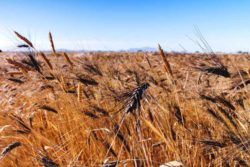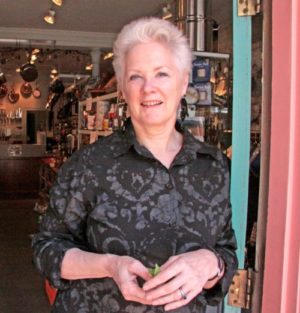Read Time: 4 Minutes Subscribe & Share
Rediscovering Wheat
Last week’s post about discovering Caputo flours for the shop really struck a chord with KD readers. So I thought I’d stay on the flour trail. This week, I want to tell you about another marvelous flour — one I discovered after I closed the store in 2018, and baked with right up until I left for Italy in 2023.
I thought I’d stay on the flour trail. This week, I want to tell you about another marvelous flour — one I discovered after I closed the store in 2018, and baked with right up until I left for Italy in 2023.
Having grown up on the familiar bags of Gold Medal and Pillsbury, the revelation of flavor and texture from more artisanal approaches to growing and milling wheat has been truly transformative. Flour isn’t just a blank canvas, but has its own character — traits that will reveal themselves in baking. Like grapes, wheat reflects not just its genetics, but its terroir — to borrow a term winemakers like to claim as their own. I get it now. I’ve also written about two small-scale wheat growers in the U.S. that I loved baking with
A Focus On Family Flours
If you enjoy the adventure of baking, do try the flours from Hayden Mills, a father-daughter operation in Arizona. They grow and mill unusual grains, including a new tortilla flour I’d love to get my hands on. (They don’t understand the joy of a real tortilla in Bologna, and while I am on the subject, guacamole here could use some help too.) My favorite from their earlier line was Blue Beard Durum. They’re now producing flour tailored to the exacting specs of Maurizio Leo, founder of The Perfect Loaf — a name you should know, along with Daniel Leader, and Peter Reinhart, if you’ve ever wandered into the world of sourdough. I have included a riveting video of Daniel Leader below, because I think he embodies the culture of wheat and baking.
operation in Arizona. They grow and mill unusual grains, including a new tortilla flour I’d love to get my hands on. (They don’t understand the joy of a real tortilla in Bologna, and while I am on the subject, guacamole here could use some help too.) My favorite from their earlier line was Blue Beard Durum. They’re now producing flour tailored to the exacting specs of Maurizio Leo, founder of The Perfect Loaf — a name you should know, along with Daniel Leader, and Peter Reinhart, if you’ve ever wandered into the world of sourdough. I have included a riveting video of Daniel Leader below, because I think he embodies the culture of wheat and baking.
 The second boutique flour operation is Grapewood Farm, closer to my old home in Alexandria, Virginia. I wrote about them back in winter 2021, probably the height of our collective, Covid-fueled baking mania. I baked with their flours using the signature loaf recipe from Apollonia Poilâne’s book and her MasterClass videos — and yes, her starter is still my favorite. The Sachs family, who run the farm, are champions of regenerative agriculture, working to restore farmland and wildlife around the Rappahannock River. Their flours supply several artisan bakeries in the DMV (District of Columbia, Maryland, Virginia — not the Department of Motor Vehicles). You can order directly from them and also visit their farm.
The second boutique flour operation is Grapewood Farm, closer to my old home in Alexandria, Virginia. I wrote about them back in winter 2021, probably the height of our collective, Covid-fueled baking mania. I baked with their flours using the signature loaf recipe from Apollonia Poilâne’s book and her MasterClass videos — and yes, her starter is still my favorite. The Sachs family, who run the farm, are champions of regenerative agriculture, working to restore farmland and wildlife around the Rappahannock River. Their flours supply several artisan bakeries in the DMV (District of Columbia, Maryland, Virginia — not the Department of Motor Vehicles). You can order directly from them and also visit their farm.
And then, further north, in the province of Quebec, I found La Meunerie Milanaise — a family-run flour mill that’s been in operation since 1980. I only wish I had discovered them before I closed the shop, because we absolutely would have carried their flours. I bought mine through International Gourmet Foods, but apparently some Costco outlets carry some of their flours now, too.
discovered them before I closed the shop, because we absolutely would have carried their flours. I bought mine through International Gourmet Foods, but apparently some Costco outlets carry some of their flours now, too.
La Meunerie Milanaise produces only organic flours — which includes glyphosate-free and non GMO status, both underreported issues in North American wheat production, no matter which side of the 49th parallel you’re standing on. Some bakers I know who trained in France say Milanaise flours remind them of French artisanal ones.
The company’s founder, Robert Beauchemin, took a life-changing trip in the 1970s to study African agriculture, and it reshaped how he viewed farming and its connection to culture. He wrote:
“What an ambiguous relationship with the land we often have, and how that relationship truly defines us. Culture, in the broadest sense of the term, comes from agriculture — from our concerns, our worries, and our love of food.”
Like Caputo, Milanaise mills specific strains of grain to produce flours with a purpose: baguettes, croissants, bagels, pizza, cookies — even one for dusting doughs. The one I used most often was their T65, which is similar to an Italian tipo 0. French flour numbers (T80, T110, T150) refer to ash content — the mineral content left after burning a flour sample at high temperature. This indicates how much bran is left in the flour. This in turn guides the baker into how to best use the flour. A T65 has about 0.65% ash, slightly higher than most American all-purpose flours, and you’ll see and taste the difference. It’s milled from soft wheat, is not blindingly white like bleached AP flour, and it worked beautifully in breads, crackers, and most pastries.
Whether it’s Hayden Mills, Grapewood, Caputo, or Milanaise, these producers — varied in size and nationality — are leading a quiet revolution. They grow and mill wheat to showcase the seed itself, without the additives and chemical shortcuts that have flattened the flavor of modern flour. They remind us that flour can have flavor, texture, and a sense of place. Each of these mills — regardless of size or country — is part of something larger: a quiet but essential return to growing wheat for flavor and health, not just yield. No glyphosate, no additives. Just grain, soil, and time.

Kitchen Detail shares under the radar recipes, explores the art of cooking, the stories behind food, and the tools that bring it all together, while uncovering the social, political, and environmental truths that shape our culinary world.




Comments are closed here.
Follow this link to create a Kitchen Detail account so that you can leave comments!